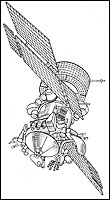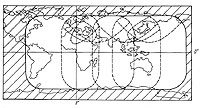Gorizont comsat (11F662) (original) (raw)
The Gorizont (Horizon) spacecraft was developed by the NPO PM development center in the Siberian city of Zheleznogorsk during the 1970s, as a follow-on generation to the Ekran series of satellites.
As his predecessor, the Gorizont was designed to ride the Proton/Block D combination into geostationary orbit over the Equator. However, unlike Ekran, the Gorizont was the first Soviet civilian communications satellite to sport multiple transponders. It was also equipped with the improved three-axis attitude control system and solar panels capable of independent tracking of the Sun to optimize power supply.
Gorizont specs (205):
| Mass | 2,150-2,200 kilograms |
|---|---|
| Number of transponders | 8 |
| Capacity of the power supply system | 1,280 Watts |
| Attitude control accuracy | 0.5 degrees |
| Orbit correction accuracy | Longitude: 0.5 degrees Inclination: 2 degrees |
| Operational life span | 3 years |
| Dimensions | 5,450 x 3,300 x 9,460 millimeters |
The Gorizont spacecraft (industrial designation 11F662) was designed for multiple communication functions:
- Transmission of TV programs from Moscow, capitals of Soviet republics and regional networks;
- Telephone and telegraph communications, providing between 800-1,000 phone channels; (204)
- Communications between sea vessels and their control facilities;
- Transmission of newspaper layouts;
For the Gorizont system, the USSR reserved several orbital positions on the geostationary orbit over the Equator with following longitudes:
- West: 14, 11 degrees
- East:40, 53, 80, 90, 96.5, 103, 140 degrees
Two of eight transponders onboard Gorizont were dedicated to TV broadcasts. The satellite was capable of broadcasting the signal on the ground antennas as small as 2.5 meters, with simplified guidance mechanism, comparing to previous systems. Such receiving stations became known as "Moskva." The spacecraft could also provide signals to the older "Orbita" ground stations with 12-meter antennas. Finally, the Gorizont would support Intersputnik network, providing broadcasts outside the USSR, primarily to the Soviet allies. (126)
During the Soviet period, Ministry of Communications managed the Gorizont network. As an "experiment" in economic policy, sometimes around 1990, Ministry of Communications offered payments to the Russian military for launch and flight control of these satellites -- a novel move for state-run bureaucracies. In the post-Soviet period, such interaction would become a norm. (119)
Deployment of the system
The first launch of the Gorizont spacecraft took place on December 19, 1978, however it was apparently injected into a wrong orbit and the Soviet sources had never listed it among operational satellites. (2) Two more satellites flew in 1979 and one in 1980.
Two operational Gorizonts, "hanging" at 4 degrees West and 53 degrees East, played a crucial role in providing TV broadcasts to more than 30 countries during Moscow Olympics in the summer of 1980. One of these satellite had to be launched only days before the Olympics, putting serious pressure on the personnel of Proton launch facilities in Baikonur. Technical problems with the payload forced prolonged maintenance of the Proton rocket on the launch pad. After the launch on June 14, the satellite was successfully activated on July 2, 1980.
In 1988, the Gorizont spacecraft "hanging" at 170 West longitude was a part of the complex communications network, providing telemetry relay for the test flight of the Buran reusable orbiter. (76)
From 1994, orbital duties of the Gorizont satellites were gradually taken over by more advanced Express spacecraft. After 1996, the launch of the last Gorizont spacecraft (production No. 45) was continuously delayed by funding problems, and it would likely never flown if not the failure of the Proton rocket in October 1999. The accident resulted in the loss of the first Express-A spacecraft, leaving Russia's orbital positions in the geostationary orbit under threat of expiration. The same failure also prompted urgent modifications in the engines powering the second and the third stage of the vehicle.
To validate the modified Proton engines and fill Russia's orbital positions as soon as possible, Russian Aviation and Space Agency, Rosaviacosmos, chose Gorizont No. 45 as the payload for the test launch. It flew successfully on June 6, 2000.
A complete list of Gorizont launches:
(All launches from Baikonur onboard Proton-K rocket. Block D (11S861) upper stage was used in all launches except the last, when the Breeze-M (14S43) upper stage was successfully tested in flight for the first time.)
| Launch date | Time of launch* | Name | Launch complex | Launch pad | Results |
|---|---|---|---|---|---|
| 12/19/1978 | 15:15 | Gorizont-1 | 200 | 40 | Failure |
| 7/6/1979 | 02:00 | Gorizont-2 Statsionar-4 | 200 | 40 | Success |
| 12/28/1979 | 14:51 | Gorizont-3 Statsionar-5 | 200 | 40 | Success |
| 6/14/1980 | 03:50 | Gorizont-4 | 200 | 39 | Success |
| 3/15/1982 | 07:39 | Gorizont-5 Statsionar-5 | 200 | 39 | Success |
| 10/20/1982 | 19:26 | Gorizont-6 | 200 | 40 | Success |
| 7/1/1983 | 02:56 | Gorizont-7 Statsionar-4 | 200 | 39 | Success |
| 11/30/1983 | 16:51 | Gorizont-8 Statsionar-5 | 200 | 39 | Success |
| 4/22/1984 | 21:21 | Gorizont-9 | 200 | 39 | Success |
| 8/2/1984 | 00:37 | Gorizont-10 | 200 | 40 | Success |
| 1/18/1985 | 03:25 | Gorizont-11 | 200 | 39 | Success |
| 6/10/1986 | 03:49 | Gorizont-12 | 200 | 40 | Success |
| 11/18/1986 | 17:08 | Gorizont-13 | 200 | 39 | Success |
| 5/11/1987 | 15:45 | Gorizont-14 | 200 | 39 | Failure |
| 1/18/1988 | 12:58 | Gorizont | 200 | 40 | Failure |
| 3/31/1988 | 07:15 | Gorizont-15 | 200 | 40 | Success |
| 8/18/1988 | 22:52 | Gorizont-16 | 200 | 40 | Success |
| 1/26/1989 | 12:16 | Gorizont-17 | 200 | 40 | Success |
| 7/6/1989 | 01:45 | Gorizont-18 | 200 | 40 | Success |
| 9/28/1989 | 20:05 | Gorizont-19 | 200 | 40 | Success |
| 6/21/1990 | 02:36 | Gorizont-20 | 200 | 40 | Success |
| 11/3/1990 | 17:40 | Gorizont-21 (No. 32) L | 81 | 23 | Success |
| 11/23/1990 | 16:22 | Gorizont-22 | 200 | 39 | Success |
| 7/2/1991 | 07:53 | Gorizont-23 | 200 | 39 | Success |
| 10/23/1991 | 18:25 | Gorizont-24 | 200 | 39 | Success |
| 4/2/1992 | 04:50 | Gorizont-25 (No. 36) Statsionar-21 | 81 | 23 | Success |
| 7/15/1992 | 01:02 | Gorizont-26 (No. 37) Statsionar-11 | 81 | 23 | Success |
| 11/27/1992 | 16:10 | Gorizont-27 | 81 | 23 | Success |
| 5/27/1993 | 04:22 | Gorizont | 81 | 23 | Failure |
| 10/28/1993 | 18:17 | Gorizont-28 (No. 40) Statsionar-14 | 81 | 23 | Success |
| 11/18/1993 | 16:55 | Gorizont-29 (No. 41) LMI AP-1 Tongasat AP-1 | 81 | 23 | Success |
| 5/20/1994 | 05:01 | Gorizont-30 (No. 42) LMI AP-2 Tongasat AP-4 | 81 | 23 | Success |
| 1/25/1996 | 12:56 | Gorizont-31 (No. 43) Statsionar-12 | 200 | 39 | Success |
| 5/25/1996 | 05:05 | Gorizont-32 (No. 44) Statsionar-5 | 200 | 39 | Success |
| 6/6/2000 | 05:58:59 | Gorizont-33 (No. 45) | 81 | 24 | Success |
*Moscow Decree Time

The Gorizont spacecraft. Credit: NPO PM

The area coverage of the Gorizont network. Credit: NPO PM